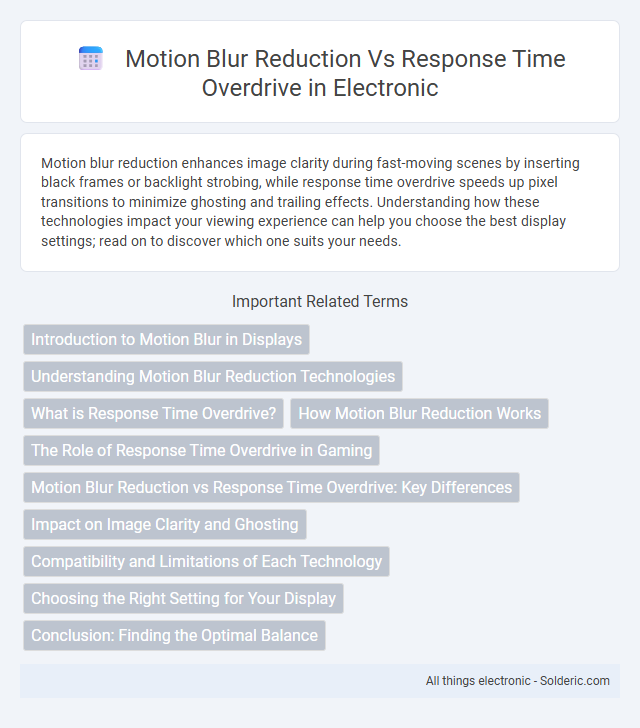Motion blur reduction enhances image clarity during fast-moving scenes by inserting black frames or backlight strobing, while response time overdrive speeds up pixel transitions to minimize ghosting and trailing effects. Understanding how these technologies impact your viewing experience can help you choose the best display settings; read on to discover which one suits your needs.
Comparison Table
| Feature | Motion Blur Reduction (MBR) | Response Time Overdrive (RTO) |
|---|---|---|
| Definition | Technique that reduces perceived motion blur by controlling backlight or inserting black frames. | Technology that accelerates pixel transitions to decrease gray-to-gray response time. |
| Primary Benefit | Sharper motion clarity during fast-moving scenes. | Minimized ghosting and smearing on screen. |
| Implementation | Backlight strobing or inserted black frames synchronized with refresh rate. | Voltage boost applied to pixels to speed up transition times. |
| Common Use Case | Gaming monitors for improved visual fluidity. | General displays aiming to reduce motion artifacts. |
| Trade-offs | Possible flicker or reduced brightness. | Increased risk of overshoot or inverse ghosting. |
| Effect on Visual Quality | Enhanced sharpness during motion; slight dimming. | Cleaner transitions; potential minor artifacts. |
Introduction to Motion Blur in Displays
Motion blur in displays occurs when fast-moving images appear smeared or less sharp, impacting visual clarity and gaming experiences. Motion Blur Reduction technology combats this by inserting black frames or strobes to minimize perceived blur, enhancing image sharpness during motion. Response Time Overdrive accelerates pixel transitions to reduce ghosting, but may not fully eliminate motion blur caused by eye persistence.
Understanding Motion Blur Reduction Technologies
Motion blur reduction technologies enhance visual clarity by increasing frame visibility through methods like backlight strobing, which reduces eye-tracking blur without significantly impacting brightness. Response time overdrive improves pixel transition speeds to minimize ghosting artifacts, offering sharper images during fast motion. Your choice between these depends on whether you prioritize eliminating motion blur or reducing pixel response delays for smoother visuals.
What is Response Time Overdrive?
Response Time Overdrive is a technology designed to accelerate pixel transitions on monitors, minimizing motion blur by reducing the time pixels take to change from one color to another. This feature enhances the clarity of fast-moving images, making it essential for gaming and action-packed visuals. While Motion Blur Reduction works by inserting black frames to cut perceived blur, Response Time Overdrive directly optimizes pixel speed, offering a sharper and more responsive viewing experience.
How Motion Blur Reduction Works
Motion Blur Reduction works by inserting black frames or backlight strobing between regular frames to minimize the perception of motion blur on LCD screens. This technique reduces the eye's tracking of moving images by shortening the time each frame remains visible, enhancing clarity during fast motion scenes. The result is a sharper, clearer picture that improves visual performance in gaming and high-speed video playback.
The Role of Response Time Overdrive in Gaming
Response Time Overdrive significantly enhances gaming performance by reducing pixel transition times, resulting in crisper images and smoother motion clarity. This technology minimizes ghosting and trailing effects, which are critical for fast-paced games that require quick reflexes and accurate visuals. By optimizing pixel response without compromising color accuracy, Response Time Overdrive delivers a more immersive and competitive gaming experience.
Motion Blur Reduction vs Response Time Overdrive: Key Differences
Motion Blur Reduction minimizes image blur by inserting black frames or backlight strobing, enhancing perceived sharpness during fast motion. Response Time Overdrive accelerates pixel transition speeds to reduce ghosting and trailing effects but does not directly affect image clarity like motion blur reduction. Your choice depends on whether you prioritize sharper motion visuals (Motion Blur Reduction) or reduced pixel response artifacts (Response Time Overdrive).
Impact on Image Clarity and Ghosting
Motion Blur Reduction enhances image clarity by inserting black frames or strobes between refresh cycles, effectively reducing perceived motion blur without increasing pixel response time. Response Time Overdrive accelerates pixel transitions, minimizing ghosting artifacts caused by slow pixel response but may introduce inverse ghosting or overshoot if over-applied. Your choice between the two technologies depends on whether you prioritize sharper motion clarity or reduced ghosting in fast-moving scenes.
Compatibility and Limitations of Each Technology
Motion blur reduction technology is compatible primarily with LCD displays, improving image clarity by inserting black frames or strobes to reduce perceived blur, but it may cause flicker and reduce brightness. Response time overdrive enhances pixel transition speeds by adjusting voltage levels, which is compatible with most LCD monitors but can introduce inverse ghosting artifacts. Both technologies have limitations in compatibility with OLED panels, as motion blur reduction can interfere with their self-emissive pixels, and overdrive methods may not effectively address their unique pixel response characteristics.
Choosing the Right Setting for Your Display
Selecting the right display setting depends on balancing motion blur reduction and response time overdrive to enhance visual clarity during fast-moving scenes. Motion blur reduction minimizes perceived blur by inserting black frames or strobing the backlight, while response time overdrive accelerates pixel transitions to reduce ghosting artifacts. Your choice should consider the type of content you view and your preference for smoother motion or reduced artifacts, optimizing your overall viewing experience.
Conclusion: Finding the Optimal Balance
Achieving the optimal balance between Motion Blur Reduction and Response Time Overdrive depends on display technology and user preference for motion clarity and input lag. Motion Blur Reduction enhances perceived sharpness by inserting black frames or strobing backlight, while Response Time Overdrive accelerates pixel transitions to reduce ghosting. Combining both features can optimize visual performance, but excessive use may introduce flickering or artifacts, so calibrated adjustments based on monitor specifications yield the best results.
Motion Blur Reduction vs Response Time Overdrive Infographic

 solderic.com
solderic.com